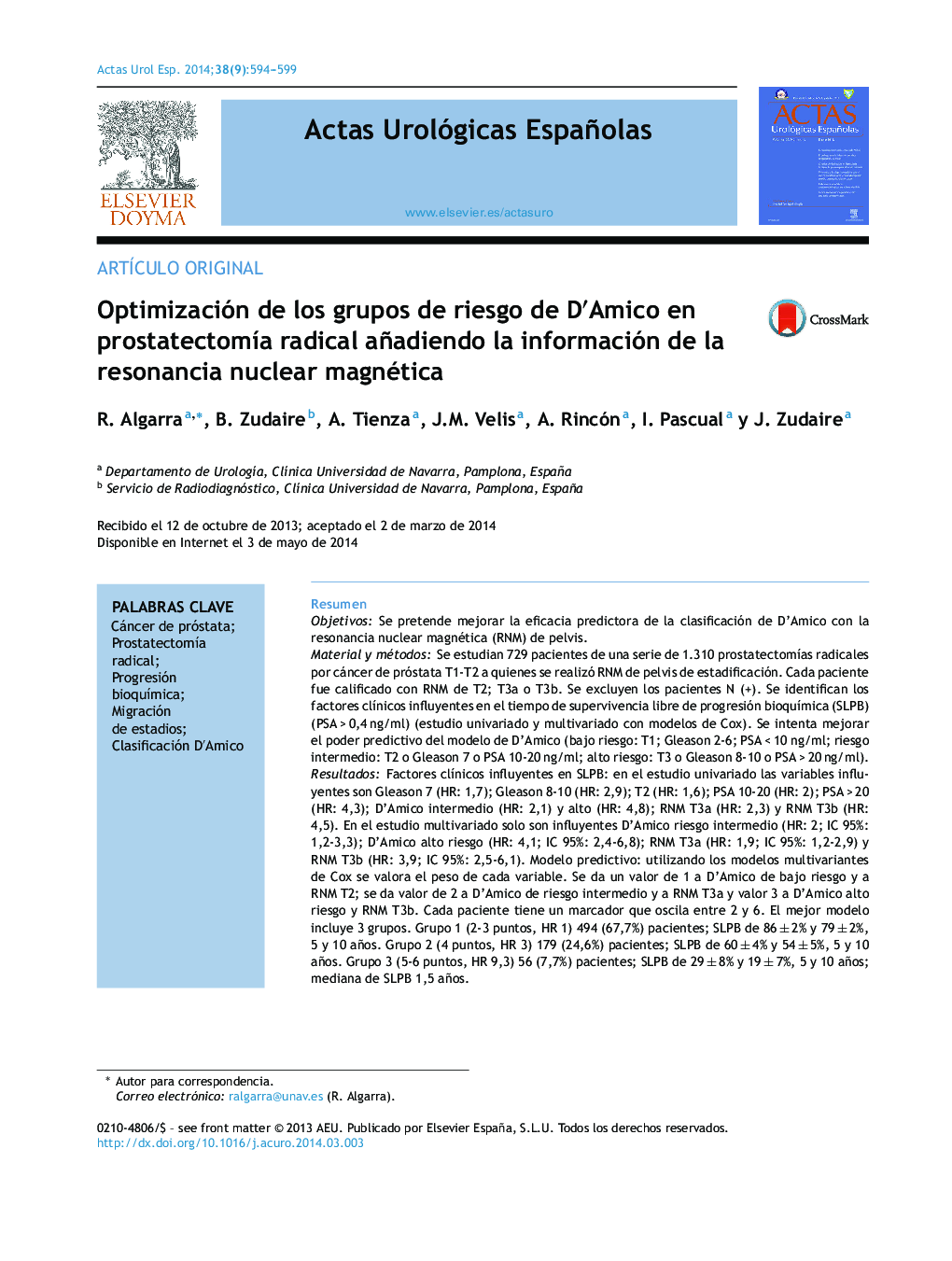| Article ID | Journal | Published Year | Pages | File Type |
|---|---|---|---|---|
| 3843389 | Actas Urológicas Españolas | 2014 | 6 Pages |
ResumenObjetivosSe pretende mejorar la eficacia predictora de la clasificación de D’Amico con la resonancia nuclear magnética (RNM) de pelvis.Material y métodosSe estudian 729 pacientes de una serie de 1.310 prostatectomías radicales por cáncer de próstata T1-T2 a quienes se realizó RNM de pelvis de estadificación. Cada paciente fue calificado con RNM de T2; T3a o T3b. Se excluyen los pacientes N (+). Se identifican los factores clínicos influyentes en el tiempo de supervivencia libre de progresión bioquímica (SLPB) (PSA > 0,4 ng/ml) (estudio univariado y multivariado con modelos de Cox). Se intenta mejorar el poder predictivo del modelo de D’Amico (bajo riesgo: T1; Gleason 2-6; PSA < 10 ng/ml; riesgo intermedio: T2 o Gleason 7 o PSA 10-20 ng/ml; alto riesgo: T3 o Gleason 8-10 o PSA > 20 ng/ml).ResultadosFactores clínicos influyentes en SLPB: en el estudio univariado las variables influyentes son Gleason 7 (HR: 1,7); Gleason 8-10 (HR: 2,9); T2 (HR: 1,6); PSA 10-20 (HR: 2); PSA > 20 (HR: 4,3); D’Amico intermedio (HR: 2,1) y alto (HR: 4,8); RNM T3a (HR: 2,3) y RNM T3b (HR: 4,5). En el estudio multivariado solo son influyentes D’Amico riesgo intermedio (HR: 2; IC 95%: 1,2-3,3); D’Amico alto riesgo (HR: 4,1; IC 95%: 2,4-6,8); RNM T3a (HR: 1,9; IC 95%: 1,2-2,9) y RNM T3b (HR: 3,9; IC 95%: 2,5-6,1). Modelo predictivo: utilizando los modelos multivariantes de Cox se valora el peso de cada variable. Se da un valor de 1 a D’Amico de bajo riesgo y a RNM T2; se da valor de 2 a D’Amico de riesgo intermedio y a RNM T3a y valor 3 a D’Amico alto riesgo y RNM T3b. Cada paciente tiene un marcador que oscila entre 2 y 6. El mejor modelo incluye 3 grupos. Grupo 1 (2-3 puntos, HR 1) 494 (67,7%) pacientes; SLPB de 86 ± 2% y 79 ± 2%, 5 y 10 años. Grupo 2 (4 puntos, HR 3) 179 (24,6%) pacientes; SLPB de 60 ± 4% y 54 ± 5%, 5 y 10 años. Grupo 3 (5-6 puntos, HR 9,3) 56 (7,7%) pacientes; SLPB de 29 ± 8% y 19 ± 7%, 5 y 10 años; mediana de SLPB 1,5 años.ConclusiónEl modelo D́Amico mejora significativamente la capacidad de predicción de la SLPB utilizando la información de la RNM.
ObjectivesTo improve the predictive efficacy of the D’Amico risk classification system with magnetic resonance imaging (MRI) of the pelvis.Material and methodsWe studied 729 patients from a series of 1310 radical prostatectomies for T1-T2 prostate cancer who underwent staging pelvic MRI. Each patient was classified with T2, T3a or T3b MRI, and N (+) patients were excluded. We identified the therapeutic factors that affected the biochemical progression-free survival (BPFS) time (prostate specific antigen [PSA] levels > 0.4 ng/mL) using a univariate and multivariate study with Cox models. We attempted to improve the predictive power of the D’Amico model (low risk: T1; Gleason 2-6; PSA levels < 10 ng/mL; intermediate risk: T2 or Gleason 7 or PSA levels 10-20 ng/mL; high risk: T3 or Gleason 8-10 or PSA levels > 20 ng/mL).ResultsIn the univariate study, the clinical factors that influenced BPFS were the following: Gleason 7 (HR: 1.7); Gleason 8-10 (HR: 2.9); T2 (HR: 1.6); PSA levels 10-20 (HR: 2); PSA levels > 20 (HR: 4.3); D’Amico intermediate (HR: 2.1) and high (HR: 4.8) risk; T3a MRI (HR: 2.3) and T3b MRI (HR: 4.5). In the multivariate study, the only variables that affected BPFS were the following: D’Amico intermediate risk (HR: 2; 95% CI 1.2-3.3); D’Amico high risk (HR: 4.1; 95% CI 2.4-6.8); T3a MRI (HR: 1.9; 95% CI 1.2-2.9) and T3b MRI (HR: 3.9; 95% CI 2.5-6.1). Predictive model: Using the multivariate Cox models, we assessed the weight of each variable. A value of 1 was given to D’Amico low risk and T2 MRI; a value of 2 was given to D’Amico intermediate risk and T3a MRI and a value 3 was given to D’Amico high risk and T3b MRI. Each patient had a marker that varied between 2 and 6. The best model included 3 groups, as follows: 494 (67.7%) patients in group 1, with a score of 2-3 points (HR, 1), a BPFS of 86% ± 2% and 79% ± 2% at 5 and 10 years, respectively; 179 (24.6%) patients in group 2, with a score of 4 points (HR, 3), a BPFS of 60% ± 4% and 54% ± 5% at 5 and 10 years, respectively; and 56 (7.7%) patients in group 3, with a score of 5-6 points (HR, 9.3), a BPFS of 29% ± 8% and 19% ± 7% at 5 and 10 years, respectively. The median BPFS time was 1.5 years.ConclusionMRI data significantly improves the predictive capacity of BPFS when using the D’Amico model data.
